
Cambridgeshire is a ceremonial county in the East of England and East Anglia. It is bordered by Lincolnshire to the north, Norfolk to the north-east, Suffolk to the east, Essex and Hertfordshire to the south, and Bedfordshire and Northamptonshire to the west. The largest settlement is the city of Peterborough, and the city of Cambridge is the county town.
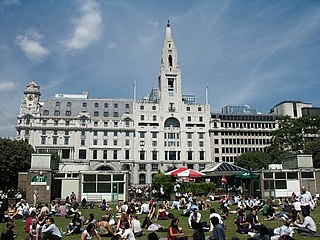
Finsbury is a district of Central London, forming the southeastern part of the London Borough of Islington. It borders the City of London.

Eel Pie Island is an 8.9-acre (3.6 ha) island in the River Thames at Twickenham in the London Borough of Richmond upon Thames. It is on the maintained minimum head of water above the only lock on the Tideway and is accessible by boat or from the left bank by footbridge. The island had a club that was a major venue for jazz and blues in the 1960s.

Windmill Hill is a Neolithic causewayed enclosure in the English county of Wiltshire, part of the Avebury World Heritage Site, about 1 mile (2 km) northwest of Avebury. Enclosing an area of 21 acres (8.5 ha), it is the largest known causewayed enclosure in Britain. The site was first occupied around 3800 BC, although the only evidence is a series of pits apparently dug by an agrarian society using Hembury pottery.
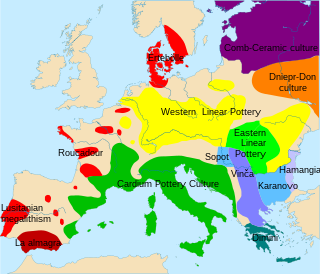
Cardium pottery or Cardial ware is a Neolithic decorative style that gets its name from the imprinting of the clay with the heart-shaped shell of the Corculum cardissa, a member of the cockle family Cardiidae. These forms of pottery are in turn used to define the Neolithic culture which produced and spread them, commonly called the "Cardial culture".
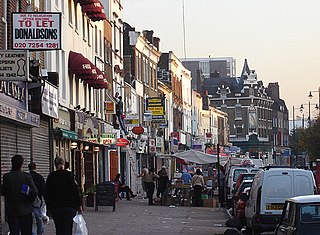
Kingsland was a small road-side settlement centred on Kingsland High Street on the Old North Road, around the junction with Dalston Lane. It is no longer discernable as a separate settlement, though the historic street pattern remains. Since the opening of Dalston Junction station in 1865, the area has become known as Dalston, which was originally a separate hamlet further east. Historically part of the county of Middlesex, the area is within the London Borough of Hackney.

The Coopers' Company and Coborn School is a secondary school and sixth form with academy status, located in Upminster area of the London Borough of Havering, England.
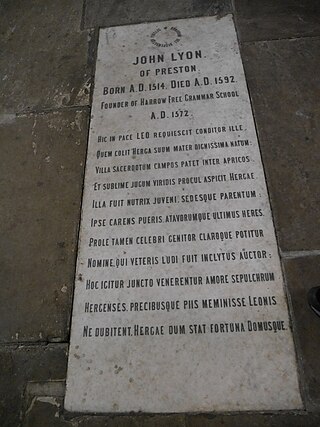
John Lyon (1514–1592) was a significant English landowner, who by 1564 had the largest land-rental income in Harrow, and who was the founder of Harrow School and the John Lyon's Charity. The John Lyon School was named as such in his recognition. The Harrow School house, Lyon's, is also named after him. He was a member of the Anglo-Norman Lyons family, and was a first cousin of Sir John Lyon, who was Lord Mayor of London for 1554 to 1555.

The Diocese of Westminster was a short-lived diocese of the Church of England, extant from 1540 to 1550. Westminster Abbey served as its cathedral.

Finsbury Circus is a park in the Coleman Street Ward of the City of London, England. The 2 acre park is the largest public open space within the City's boundaries.

Hoxton Square is a public garden square in the Hoxton area in the London Borough of Hackney. Laid out in 1683, it is thought to be one of the oldest in London. Since the 1990s it has been at the heart of the Hoxton national arts and media hub, as well as hosting entertainment, with globally eclectic musicians, actors and dancers. Most of the square's buildings, quite tall for the Victorian age, diverge in use, with many floors converted to bars, restaurants and offices and at least one live music club of note.

Enfield Grammar School is a boys' comprehensive school and sixth form with academy status, founded in 1558, situated in Enfield Town in the London Borough of Enfield in North London.
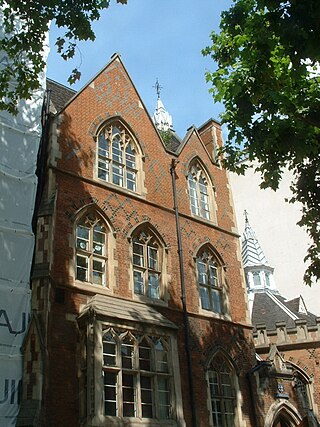
St Marylebone Grammar School (SMGS) was a grammar school located in the London borough of the City of Westminster, from 1792 to 1981.
Enfield-chantry school was a chantry school in Enfield from c. 1398–1558, and the predecessor of Enfield Grammar School.
Ruislip Priory was a priory in Middlesex, England. In 1086 or 1087 the manor of Ruislip was given to Bec Abbey by Ernulf de Hesdin. An administrative centre, it had a priory before 1200. In the early 13th century the administration of Bec's manors was shared with Ogbourne Priory in Wiltshire. As one of the alien priories, Ruislip shared their varying fortunes. Ruislip was always a manor-house rather than having conventual buildings. After 1404 the manors were reallocated, Ruislip going to St Nicolas College, Cambridge. St Nicolas College was later renamed King's College.

Whitehawk Camp is the remains of a causewayed enclosure on Whitehawk Hill near Brighton, East Sussex, England. Causewayed enclosures are a form of early Neolithic earthwork that were built in England from shortly before 3700 BC until at least 3500 BC, characterized by the full or partial enclosure of an area with ditches that are interrupted by gaps, or causeways. Their purpose is not known; they may have been settlements, or meeting places, or ritual sites. The Whitehawk site consists of four roughly concentric circular ditches, with banks of earth along the interior of the ditches evident in some places. There may have been a timber palisade on top of the banks. Outside the outermost circuit there are at least two more ditches, one of which is thought from radiocarbon evidence to date to the Bronze Age, about two thousand years after the earliest dated activity at the site.

Dark faced burnished ware or DFBW is the second oldest form of pottery developed in the western world, the oldest being Dotted wavy line pottery from Africa.

Baker's Hole is a 6.9 hectares geological Site of Special Scientific Interest, mostly consisting of a back-filled quarry, adjacent to Ebbsfleet International railway station in Kent. It is a Geological Conservation Review site. It is a nationally significant site for finds during quarrying of Stone Age tools, which are now dispersed among many museums.
Pottery began to appear at the start of the British Neolithic period, along with other changes in lifestyle. These changes included a switch to settled agriculture, as opposed to hunting and gathering.

















